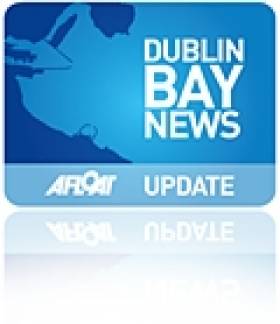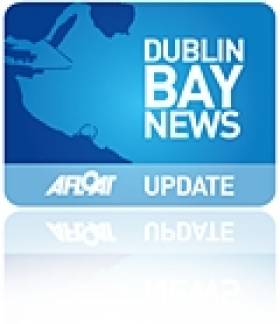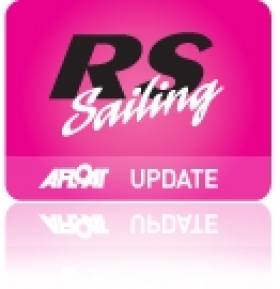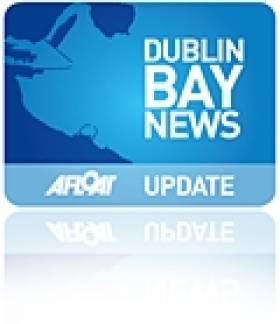Displaying items by tag: dmyc
#dbsc – Strong westerly winds gusting to 40 knots put paid to both the DBSC Spring Chicken handicap keelboat series and the DMYC dinghy frostbites on Dublin bay today.
The cruiser event was abandoned just before its first gun this morning. It is the second week running that strong winds have forced cancellation. The plan now, say organisers, is to run an extra race on March 22nd with no race on the 15th due to St. Patrick's weekend.
Strong Winds Cancel Dublin Bay Spring Chicken & DMYC Frostbite Series
#dbsc – Although Kinsale's natural harbour may have provided the necessary protection for the penultimate round of the south coast town's Frostbite series yesterday, there was no such shelter from the winds on the east coast with both of Sunday's Dublin Bay sailing fixures cancelled. DBSC's cruiser Spring Chicken organisers were forced to cancel in the morning and the DMYC dinghy frostbite series followed suit yesterday afternoon as gusts hit 40–knots off Dun Laoghaire harbour.
Big PY Dinghy Fleet on a Chilly Day for DMYC Frostbite
#pyfleet – The PY fleet turned out in good numbers for yesterday's DMYC frostbite series and despite the weather had a great day's racing after all writes Hugh Sheehy. Cold water temperatures and winds gusting from 10 knots to 28 knots led to some conservative sailing, but the racing was still pretty full on.
At the end the result continued the recent strong run by the Finns, with Richard Tate leading the way home from Long and Hamilton in the IDRA14s.
Tate started with the main group down at the pin while Des Fortune's Finn timed a gust right and got a big right shift off the boat end right at the gun. Fortune's boat was clearly ahead at the first mark with Tate and Long chasing hard back in from the left. It was PUFFY under the weather mark.
Careful sailing was the order of business down the run with booms not let too far out and some spinnakers not-flying. Tate and Fortune's Finns started to pull clear on the 2nd beat before Fortune's boat retired leaving Tate to sail out to victory. A nice win, although not by a big margin, with Long only 20 seconds behind on corrected time. And although Hamilton was a full two minutes further back he only had ten seconds over Tom Murphy in the K1.
The most notable result was the one second difference between Devaney and Lordan in 5th and 6th. Tight times!
PY and Laser fleets each had 13 boats on the water, with the RS and Fireball fleets disappointed to see only 5 boats in each class. But it was a good day.
A good day! And a good day to have a good wetsuit too!
Five Fireballs Come Out to Play at DMYC Dinghy Frostbites
#frostbites – Only five Fireballs sailed the single race in today's offering from the DMYC's Frostbite organisers. Messrs, McCartin, Butler, Rumball, Clancy, their respective crews and Louise McKenna and crew made up the starters writes Cormac Bradley.
The weather station adjacent the HSS Terminal and the Windfinder App were in agreement about some of the conditions – the weather station was recording a wind direction of 172˚, a base wind strength of 10.8 knots and a recorded gust of 21.7 knots, air temperature was a balmy (for February) 8.9˚. Windfinder predicted the direction as southerly, with a wind strength that would vary from 18 – 20 knots with gusts of 22 – 26 knots between 12 noon and 15:00.
The gusts were certainly there giving the fleet some interesting spinnaker legs, particularly on the top and bottom legs of the trapezoid course which was set in the middle and western half of Dun Laoghaire harbour – a weather mark just of the end of the HSS Ferry Gantry, No. 2 just inside the end of the East Pier, No. 3 in the middle of the harbour mouth and No. 4 off what I would refer to as the "blockhouse" on the West Pier.
"Cats paws" of harder wind were blowing across the course all afternoon and these provided some fun on the off-wind legs.
The fight at the start was to secure the slot beside the committee boat – four boats went for this as Louise was slightly delayed on her way out to the start. Ultimately, it was won by Rumball and Byrne (15058), but not before McCartin and Kinsella came in too early (from my position) and had to "bale out". The previous starts (PY Class, Lasers, RS 200 & 400s) suggested that the way to go was left, but McCartin & Kinsella, taking an early hitch to the right, subsequently crossed the other three on starboard tack and never looked back, leading from this initial crossing all the way to the finish. Butler & Oram (15061), Clancy & Clancy (15113) and Rumball & Byrne (15058) were in close company, until Rumball/Byrne capsized in a tack and fell out the back of the train. This "snookered" their race for though they got close enough to Clancy/Clancy to have the latter watching them carefully, they never recovered, place-wise, from their swim.
After the first weather mark there were no place changes but the relative fortunes of the boats did seem to change. At the end of the first lap McCartin & Kinsella looked very comfortable. Butler & Oram tried different things to close the gap but at each subsequent weather mark, bar the last, McCartin's lead was between 20 and 30 seconds. Only on the last beat was there a sense that Butler & Oram had dramatically closed on the leaders but at this stage McCartin & Kinsella were keeping a loose cover on them anyway. And Butler & Oram got caught up in traffic at this last weather mark to allow McCartin & Kinsella away again.
Earlier in the race it had seemed that Butler & Oram were resigned to not catching the leaders (and I realise how disrespectful that might seem) but one almost got the sense that they were covering the rest of the fleet, rather than trying to catch McCartin.
Though the weather station was recording a wind direction of 174˚, as I left my observation position, a two-degree variation from when I arrived, on the water the vagaries of the wind translated to tight reaches becoming broader reaches on the top leg of the trapezoid and decisions about two sailing or three sailing the bottom leg of the trapezoid.
|
DMYC Frostbites 2014/15 Series 2: Sunday, February 15th. |
1 |
2 |
3 |
4 |
5 |
6 |
Tot |
Nett* |
||
|
Barry McCartin & Conor Kinsella |
15114 |
RStGYC |
1 |
4 |
2 |
14 |
1 |
1 |
23 |
9 |
|
Noel Butler & Stephen Oram |
15061 |
NYC/DMYC |
2 |
3 |
1 |
2 |
3 |
2 |
13 |
10 |
|
Kenneth Rumball & Brian Byrne |
15058 |
INSC |
9 |
1 |
3 |
3 |
2 |
4 |
22 |
13 |
|
Conor & James Clancy |
15113 |
RStGYC |
9 |
5 |
4 |
1 |
4 |
3 |
26 |
17 |
*Assumes that a single discard is in play!
Today's race was Race 6 in Series 2 and the above table is my interpretation of where the leaders sit relative to each other.
Ryan Brothers Take RS Dun Laoghaire Frostbite Line Honours
#rssailing – Sunday's RS dinghy DMYC frostbites race felt like the first day spring with clear skies and a gentle force 3 breeze to get us started off which steadily increased as the day went on.
Race one again saw some some congestion on the committee boat end of the start line. However, Cleary/O'Brien combination managed to avoid this and arrived at the windward mark first with the help of a left hand shift. They were closely followed by the Ryan brothers and the Rumball boat. The positions remained the same for the rest of the lap despite traffic from the other fleets. On the next beat, the Ryan brothers and the Rumball boat went right more to the better breeze towards the harbour mouth which saw them overtake Cleary/O'Brien. The Ryan brothers then sailed off into the distance leaving the Rumball boat and Cleary/O'Brien to scrap it out. The Ryan brothers took line honors followed by the Rumball boat and then Cleary/O'Brien.
Race 2, saw the breeze begin to rise quite nicely to the stage where the RS's were planing on the spreader leg. Brian O'Hare and Alice Brennan got off to a good start leading the fleet to the first windward. The Ryan brothers and the Rumball boat eventually got past everyone and began their own match race at the front. The Ryan brothers again finished first and were closely follow by the Rumball boat and followed by Cleary/O'Brien.
Next week promises to be an even better outing with the long range forecast predicting a southerly force 4 and a tropical 9 degrees celsius.
Weekly Mug went to Clodagh Hinkson & Helen O'Beirne in the rs 200 for race 1 and Brian O'Hare & Alice Brennan for race 2.
Thanks to Sean Cleary for this week's report.
Fireball Dinghy Racing 'Gladdens The Heart' in Dun Laoghaire Harbour
#dmycfrostbites – In the presence of an unusual large high pressure over Ireland, the Fireball frostbites were greeted by a lovely 10-15kt breeze from the west, cool as it was, the warmth of the sunshine kept sailors moving for races 11 and 12 of the DMYC Frostbite series. The race committee laid a Trapezoid course inside the Harbour walls with a windward mark laid well away from the West Pier giving clear breeze all the way from the start line to the mark. With a congested start line due to a highly favoured committee boat all boats got away cleanly. Initially most of the fleet kept on starboard tack out toward the middle of the harbour, Noel Butler and Stephen Oram 15061 peeled off first to the right hand side with Kenneth Rumball and Ed Butler following suit leaving the Clancy brothers 15113 to head out to the left of the beat.
At the top mark the Clancy brothers came out on top followed by Rumball/Butler... The two boats played cat and mouse with Rumball/Butler overtaking on the next beat and holding on to their lead to take the win. A bit further back there was great racing throughout the fleet. Alistair Court and crew Gordon snapped at the leaders heels and narrowly missed third place in not one but both races. Neil Colin/Margaret Casey diced with Frank Miller/James Murphy and Louis Smyth/Glenn Fischer. Colin's light air credentials paid dividends in race one when he went hard right against many odds and came out ahead. Most of the fleet favoured working their way towards the left hand layline where a tad more pressure and a lift to the windward mark delivered rewards. Further back Mary Chambers and Brenda McGuire tussled with Louise McKenna sailing with Edward Coyne. The latter, and his family, deserves a medal for his epic journey from Youghal to make the start, with dense fog for most of the journey adding a distinct frisson of uncertainty all the way to Dun Laoghaire.

With the days getting longer, there was time for a second race, in very welcome increased pressure with full trapezing on the beats. A congested committee boat end saw Rumball/Butler and Butler/Oram getting away cleanly with a disagreement between the Clancy brothers and Colin/Casey at the committee boat. Rumball/Butler managed to tack clear of Butler/Oram to round the weather mark first and hold the lead to the finish of the three lap course. Not a huge amount of change further back though Miller/Murphy and Smyth/Fischer managed to squeeze ahead of Colin/Casey with Court/Syne having to settle again for a leather medal 4th.
In summary this was the kind of sailing day to gladden the heart, especially for February and the prospect of longer days ahead should surely entice out any remaining stragglers.
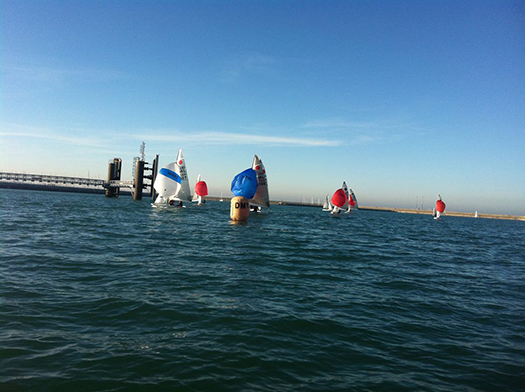
Fireball Sailing Fast, Furious & Frosty off Dun Laoghaire Harbour
#fireball – Nine Fireballs enjoyed two races yesterday in Dun Laoghaire Harbour in deceptive conditions. It was a blue sky day but the air temperature was down to just less than 5˚ and with a cold breeze blowing the chill factor would have dropped that further writes Cormac Bradley.
The weather station adjacent to my vantage point recorded a base wind strength of just over 10 knots but the highest gust of the day was 18.2 knots, air temperature was 4.7˚ and wind was recorded at 316 - 320˚ - WNW.
Again the course was a trapezoid, with a weather mark close to the starter's hut on the west pier and Marks 2 and 3 sitting either side of the HSS gantry, so much so that the gantry had to be negotiated, i.e. you couldn't sail a straight line between the two marks. Mark 4 was towards the weather station on the east pier.
The fleet hogged the committee boat end on the first start, all on starboard tack, but the peel-off to the right-hand side was initiated quite early by Louise McKenna & Hermine O'Keeffe (14691), followed by Louis Smyth & Glen Fisher (15007). In contrast, Frank Miller & Joe O'Reilly (14713) worked the LHS and it paid dividends as they rounded the weather mark in first place. However, close on their tales were the Clancy brothers Conor and James (15113). A flawless hoist by the brothers saw them surge into the lead, a position they never relinquished! In contrast Miller & 'Reilly went swimming and the complicated capsize, with spinnaker, took them out of the race altogether. The leg from 1 to 2 was quite tight and successfully negotiating this leg was key to race success. Behind the first two Noel Butler & Stephen Oram (15061), Kenneth Rumball & Brian Byrne (15058), Alistair Court & Gordon Syme (14706) and Neil Colin & Margaret Casey (14775) were in close company.
The leg from 2 to 3 required two gybes, either immediately at the mark, or delayed when sailing past the gantry for the HSS was impossible. The bottom reach was already quite tight and as the afternoon progressed, it would get even tighter wit even the top boats reduced to sailing it with two sails.
For the second beat the fleet went right with Team Clancy in a very comfortable position. At the 2nd weather mark the order was Clancy, Butler, Court, Rumball, Barry McCartin & Conor Kinsella (15114), Smyth, McKenna & Colin.
For the third beat the fleet worked the middle and left of the course with McCartin and Court out on the LHS. As Miller had proven on the first beat, this was advantageous and McCartin rounded the last weather mark in 4th, behind Clancy, Butler & Rumball. 1 to 2 was now becoming a judgement call – spinnaker or not and Court in particular sailed the leg conservatively at no cost to his place in the pecking order. His 5th place earned him the Frostbite Mugs.
|
Frostbite Series 2: Sunday 1st February Race 1. |
|||
|
1 |
Conor & James Clancy |
15113 |
RStGYC |
|
2 |
Noel Butler & Stephen Oram |
15058 |
NYC/DMYC |
|
3 |
Kenneth Rumball & Brian Byrne |
15058 |
INSC |
For the second race the committee boat was again the favoured end but this time there was a more distinct split in the fleet with four boats going right at the first available opportunity. McKenna, Miller, McCartin, Smyth & Butler worked the left hand side of the course and this paid dividends for McCartin and Butler who rounded the top mark in first and second. Again, the hoist was critical and Butler & Oram won this manoeuvre, but McCartin & Kinsella, sailing that bit higher, powered over the top of them to take the lead. Rumball & Byrne rounded ahead of Team Clancy, followed by Colin & Casey, McKenna & O'Keeffe, Smyth & Fisher, Court & Syme and Miller & O'Reilly.
Almost all the Fireballs gybed immediately at Mark 2 before a second gybe was required to get back to Mark 3 where a third gybe was required. For the first lap the top boats flew spinnakers along the bottom of the course but Aussie drops were being utilised before mark 4 was reached.
For the second beat the top three went right but Clancy worked some shifts to round the second weather mark in third place ahead of Rumball. This gave a revised order of McCartin, Butler, Clancy, Rumball, Colin, Smyth, Miller and McKenna. After a capsize on 2- 3 on the previous lap, Court & Syme retired. The legs from 1- 2 and from 2- 3 were manageable but care had to be exercised, particularly when gusts came in over the backs of the crews on 1 – 2. Leg 2 - 3 was all about timing the gybe correctly and 3 – 4 was now a high wire two sail reach.
On what was to be the last beat, McCartin and Clancy worked the left hand side while Butler and Rumball worked the middle and right. A combination of good boat speed and a more favourable angle to the weather mark on the port layline meant that McCartin was able to hold onto his lead. Clancy slotted into fourth behind the other two, with Butler ahead of Rumball. However, before the finish, Rumball would pass out Butler.
Colin & Casey were holding off Smyth & Fisher who by virtue of this 6th place were in line to take the second set of Frostbite Mugs and so it evolved.
|
Frostbites Series 2: Sunday 1st February Race 2 |
|||
|
1 |
Barry McCartin & Conor Kinsella |
15114 |
RStGYC |
|
2 |
Kenneth Rumball & Brian Byrne |
15058 |
INSC |
|
3 |
Noel Butler & Stephen Oram |
15061 |
NYC/DMYC |
After 5 races, assuming no discards, my assessment of the overall situation is as follows;
|
Frostbites Series 2: 5 Races sailed, No discard. |
||||
|
1 |
Noel Butler & Stephen Oram |
15061 |
NYC/DMYC |
11pts |
|
2 |
Kenneth Rumball & Brian Byrne |
15058 |
INSC |
18pts |
|
3 |
Barry McCartin & Conor Kinsella |
15114 |
RStGYC |
22pts |
|
4 |
Conor & James Clancy |
15113 |
RStGYC |
23pts |
On reviewing the official posted results, it seems that Messrs McCartin & Kinsella were recorded as OCS in the day’s first race.
Double Bonus for Dun Laoghaire Fireballs At DMYC Frostbites
#fireball – The Dun Laoghaire Frostbites got back on track today, Sunday 25th January, with two races in weather conditions which were also a bonus. As far back as Thursday the suggestion was that it would be blowing hard today. The Sea Area forecast from Met Eireann last night was also suggesting it would be “draughty” and lastly, the “Windfinder” App was suggesting that there would be as much as 18 knots at 15:00, this afternoon. In the end, none of them were right as the Frostbite fleet enjoyed good but challenging wind conditions in mild temperatures just into double figures. The weather station close to my vantage point was suggesting that winds of between 4 and 6 knots were blowing with gusts that got up to 12 knots. Directionally, there was some agreement on all the forecasts with a direction of SSW to SW being predicted and recorded.
In the first Fireball start the majority of the fleet were at the committee boat end but Neil Colin and Margaret Casey (14775) were at the opposite end and that certainly appeared to be the side that was favoured going up the beat. Those boats that hung out right were punished as they found themselves over-standing the first weather mark of the trapezoid course.
For a change, rather than attempt a blow by blow account of the race, the roundings of the weather mark on each of the four laps is recorded to give readers an idea of the “yo-yo-ing” that afflicted the fleet today.
|
Weather Mark Roundings |
1 |
2 |
3 |
4 |
|
Rumball & Byrne |
2 |
1 |
1 |
1 |
|
Butler & Oram |
7 |
3 |
3 |
5 |
|
McCartin & Kinsella |
3 |
4 |
4 |
2 |
|
Colin & Casey |
4 |
5 |
6 |
4 |
|
Miller & Murphy |
6 |
7 |
5 |
6 |
|
Clancy & Clancy |
1 |
2 |
2 |
3 |
|
Malcolm & O’Reilly |
5 |
8 |
8 |
7 |
|
McKenna & O’Keeffe |
9 |
6 |
7 |
9 |
|
Chambers & McGuire |
8 |
9 |
9 |
8 |
|
Smyth & Fisher |
10 |
10 |
10 |
10 |
Initially the off-wind legs of seemed to be quite simple. The top leg of the course, 1 – 2, was a tightish reach which most people three-sailed for the first couple of laps, but as the afternoon progressed this became a tighter leg and at least one Fireball sailed it as a two-sail reach and didn’t appear to lose out as a consequence. The leg from 2 – 3 was also simple enough initially, ease sheets as one rounded Mark 2 and sail to Mark 3, but on the last two laps of the trapezoid a variety of approaches were being adopted and Rumball & Byrne executed four gybes between 2 and 3 on the last lap before they went round the latter mark. The plan of attack for the beats was to stick to middle and left as going right did not pay at all. As the wind flicked one way and then another, the leg from 2 to 3 became ever more tactical and places could be snatched if you got into wind that those around didn’t have.
Frank Miller and James Murphy (14713) used this to launch a platform to attack the leaders and when the leading six boats appeared to concertina into the rounding of Mark 4 for the last time, they were able to take best advantage and pop out with a possible second place over the finish line.
As the finish was at the opposite end of the harbour to my vantage point, adjacent to the HSS gantry on the windward shore, my view of the finish was poor, but the suggestion is that the order was as follows;
|
DMYC Frostbites 2014/15 – Series 2 Round 2; 25th January. |
|||
|
1 |
Kenneth Rumball & Brian Byrne |
15058 |
INSC |
|
2 |
Frank Miller & James Murphy |
14713 |
DMYC |
|
3 |
Noel Butler & Stephen Oram |
15061 |
NYC/DMYC |
For the second race of the day, the Fireball fleet all started on port tack with the pin appearing to be the favoured end. Luke Malcolm and Harry O’Reilly (14790) were furthest away from the pin. Yet again the left-hand side of the course was where everyone wanted to be. At the weather mark the initial rounding order was Clancy, McCartin, Rumball, Butler and Colin and all five boats got a tight 3-sail reach as their reward. Again the fleet was able to ease sheets for the leg from 2 to 3 rather than gybe and as a testimony to the consistency of the breeze at this early stage the initial pecking order hadn’t changed by the time they got to Mark 3.
For the second beat the fleet went right with Rumball & McCartin keeping in very close company. Clancy was a little bit further to windward of this pair but he appeared to have lost some ground on them, meaning that despite the apparent close attention they were giving each other, he couldn’t capitalise on being the “third man”. At the second weather mark, Rumball was still in control and the leading three boats enjoyed a fast 3-sailer to Mark 2. 2 – 3 was no longer the simple leg it had been on the first lap and at the end of the leg McCartin had taken Rumball, Clancy was secure in third and Butler who though he was in fourth wasn’t anywhere near enough to get to the lead three boats.
Up the third beat and the lead two were watching each other again……..with Clancy waiting to pounce if they made a slip up. No joy! McCartin & Kinsella rounded the last weather mark in the lead but then nearly lost it all when a gust came through as they were putting up the kite. Rumball & Byrne must have seen a “literal door open and slam shut again” as the leaders escaped a swim and got control back again. As the two boats approached Mark 2 Rumball & Byrne were going faster and words could be heard between the two boats as Mark 2 loomed in front of them.
It seemed that all was “set fair” for a simple finish. The lead three boats negotiated their way to Mark 3 and for 2/3 of the leg from 3 to 4, the order seemed to be equally settled. However, even from my observation post on the opposite side of the harbour I could see that there was fun and games going on at Mark 4 – lots of overlapping spinnakers suggested that the leaders had closed in on themselves again. Rumball & Byrne got squeezed out, capsizing in the process (I found out later – from the “horse’s mouth) to leave a finishing order of Butler & Oram, McCartin & Kinsella and Rumball & Byrne.
In my estimation – without sight of the results – Miller & Murphy will pick up the Frostbite Mugs for the first race of the day, with Colin & Casey getting them for the second.
DMYC Frostbite Dinghy Racing Cancelled Again Due to Strong Winds
#dmycfrostbites – With both XCWeather and Windfinder forecasts suggesting similar conditions for 15:00, northerly winds of 20 knots with gust to 27/28 knots, air temperatures of 5/6˚, but, ironically sunny conditions, the organisers of today's DMYC Frostbites pulled the plug on the Dun Laoghaire dinghy racing series writes Cormac Bradley. N over A flies from the DMYC flagpole for yet another week!
#fireball – Irish National Fireball Champions, Barry McCartin & Conor Kinsella (IRL15114) made their Frostbite debut in Dun Laoghaire yesterday and utterly dominated proceedings, leading from start to finish and putting three-quarters of a lap between themselves and the chasing pack at the finish writes Cormac Bradley.
Eight Fireballs initiated Series 2 of the Frostbites, hosted by Dun Laoghaire Motor Yacht Club and they enjoyed lighter and more fickle conditions than were forecast for the day. The Windfinder app was suggesting 12 knots of SSW, but the weather station adjacent to my observation position suggested that the base wind strength was around 6 knots with a highest recorded gust of 10 knots and a direction of 162˚. The air temperatures of the two systems – app and weather station – were consistent at 7˚. Still, after a gap of five weeks, with the last three Sundays of Series 1 lost to adverse weather, the fleet would have enjoyed being on the water in any conditions.
Again, I missed the start (New Year’s resolution – get there on time!) and arrived as a cluster of Fireballs rounded the first weather mark. Even after a single beat, McCartin & Kinsella had some distance on the fleet. They were followed by Alistair Court & Gordon Syme (IRL 14706), Noel Butler & Stephen Oram (IRL 15061) and Neil Colin & Margaret Casey (IRL 14775). A trapezoid course was the order of the day with a long beat and a shorter top leg between 1 and 2. The weather mark was set just off the ferry gantry with the committee boat anchored off the west pier.
For the second beat, McCartin & Kinsella took a short port tack hitch before setting off on a long starboard leg to the weather mark. What appeared to be a healthy lead on the water as they approached the mark seemed to evaporate, but it was an illusion because on time they were 45 seconds up on the next boat. Court & Syme were still in second place, followed closely by Louise McKenna & Joe O’Reilly (IRL 14691), with Colin & Casey, Butler & Oram, Frank Miller (IRL 14713), Louis Smyth & Glen Fisher (IRL 15007) and Mary Chambers & Brenda McGuire (IRL 14865) following on.
The leg between 1 and 2 stayed as a tight reach throughout the race and the bottom leg, 3 to 4 was likewise tight but the leg between 2 and 3 saw two different approaches being taken, continue on starboard tack towards the harbour mouth, or gybe and sail a slightly higher line to Mark 3. At Mark 4 the second time the fleet compacted, with the exception of the leaders who at this stage were in a “world of their own”. The tactic now appeared to be to tack earlier rather than later as the boats which went too far left found themselves in lesser breeze.
At Mark 1 for the third time, the lead was out to 2 minutes, the length of the leg between 1 and 2. The chasing pack seemed to have an established order with the sequence being Butler, Court, Colin, McKenna, Smyth, Chambers & Miller. However, for the balance of the race this group of seven had a persistent game of snakes and ladders before the finishing order was confirmed.
There were two elements to the beat now – stay in breeze and stay on starboard tack for as long as possible, taking the port hitch when the wind allowed. This meant that the fleet generally stayed inside the box created by the four marks of the course.
At the next rounding of the weather mark the sequence, apart from the leaders, who now had a two leg lead, was Colin, Butler, McKenna, Court, Miller, Chambers, Smyth. However, at Mark 3 they compacted again and in the process Chambers had the “door shut” on her, forcing her to drop spinnaker and tack to round the mark.
By the next rounding of the weather mark, Colin had got ahead of Butler, but his approach to the mark was interrupted by starboard tacked boats approaching the same mark. This allowed Butler to close but not pass Colin. McKenna and Court also rounded in close company followed by Smyth, Miller and Chambers, now slightly adrift due to her travails at the previous rounding of mark 3. By mark 2, Butler had taken Colin.
As the afternoon progressed, staying in wind became the primary challenge. On the last lap, Colin sailed on past mark 2 even though both McKenna and Court who had gybed at mark 2 seemed to have gained the upper hand on the water by this manoeuvre. However, he managed to sail “a circle route” to 3 and by staying in better breeze got his third place back again.
|
DMYC Frostbites 2014/15: Series 2, Round 1; 4th January 2015. |
|||
|
1 |
Barry McCartin & Conor Kinsella |
15114 |
RStGYC |
|
2 |
Noel Butler & Stephen Oram |
15061 |
NYC & DMYC |
|
3 |
Neil Colin & Margaret Casey |
14775 |
DMYC |
|
4 |
Louise McKenna & Joe O’Reilly |
14691 |
RStGYC |
|
5 |
Alistair Court & Gordon Syme |
14706 |
DMYC |
This result gave Barry & Conor the day’s Frostbite Mugs.
The DMYC clubhouse also hosted the prizegiving for Series 1 which had not taken place in December due to the last three races being abandoned due to adverse weather. DMYC Calendars were the prizes for the Series.
|
DMYC Frostbites 2014/15: Series 1, Overall (No discards). |
Pts. |
|||
|
1 |
Kenny Rumball & Brian Byrne |
15058 |
Irish National Sailing Club |
5pts |
|
2 |
Noel Butler & Stephen Oram |
15061 |
National Yacht Club & Dun Laoghaire Motor Yacht Club |
17pts |
|
3 |
Conor & James Clancy |
15113 |
Royal St. George Yacht Club |
21pts |
Kenny Rumball was not in attendance to receive his prize as he was in Australia returning the boat in which he finished seventh in Class and 12th overall (IRC) in the 2014 Rolex Sydney to Hobart Race. He raced with two other Irish sailors with strong Fireball connections – Barry Hurley and Kenny’s younger brother Alexander.
In other Irish Fireball related news, Conor Byrne was in 25th overall, after two races, in a fleet of 124 Tasars at their World Championships in Australia. Two other Fireball “connections” are also in action at this event; Chris Payne & Heather McFarlane were 15th overall after the same two races (and they won the Practice Race) and Ben Schulz was lying in 35th overall.



























